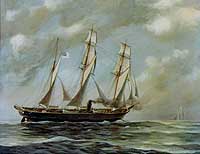 |
||||||||||||||||||||||||||||||
|
Home Ships Weapons Shipyards Newsletters Forums Contact Awards |
||||||||||||||||||||||||||||||
|
CSS Alabama was a screw sloop-of-war built at John Laird and Sons and Company, Birkenhead, England, in 1862 for the Confederacy. The famous Hull "290" was launched under the name Enrica, put to sea from Liverpool on 29 July 1862 and proceeded to Porto Praya in the Azores where Captain Raphael Semmes, CSN, and her other officers boarded and fitted her out as a cruiser. She was commissioned at sea off Terceira, Azores on 24 August as the Confederate cruiser Alabama. Semmes spent the next 2 months in the North Atlantic where he captured and burned some 20 ships, including a dozen whalers. From there he departed for the Newfoundland Banks to intercept American grain ships bound for Europe, and thence to the West Indies and the coast of Texas where Alabama sank the Federal Navy side wheel steamer Hatteras and captured her crew. Cruising along the coast of Brazil, he used the desolate island of Fernando de Noronha as a base. Shrewdly calculating the length of time necessary for word of his deeds to reach the United States Government, Semmes next put in at Cape Town and sailed for the East Indies where he spent 6 months and destroyed 7 ships before redoubling the Cape en route to Europe. Arriving at Cherbourg, France, on 11 June 1864, he hoped to be allowed to dock and overhaul his ship. As Semmes awaited permission from French authorities, Kearsarge, Capt. John A. Winslow commanding, arrived at Cherbourg, brought there by word of Alabama's presence. Kearsarge took up a patrol at the harbor's entrance awaiting Semmes' next move. Alabama's log for 15 June 1864 tells succinctly of her skipper's decision: "The admiral sent off his aid-de-camp to say to me that he considered my application for repairs withdrawn upon making application for coal, to which I assented. We commenced coaling this afternoon. The Kearsarge is still in the offing. She has not been permitted to receive on board the prisoners landed by me, to which I had objected in a letter to the admiral. Mailed a note yesterday afternoon for Flag-Officer Barron, informing him of my intention to go out to engage the enemy as soon as I could make my preparations, and sent a written notice to the U.S. consul, through Mr. Bonfils, to the same effect. My crew seem to be in the right spirit, a quiet spirit of determination pervading both officers and men. The combat will no doubt be contested and obstinate, but the two ships are so equally matched that I do not feel at liberty to decline it. God defend the right, and have mercy upon the souls of those who fall, as many of us must. Barometer low, and weather unusually cold and blustering for the middle of June." On 19 June 1864, Alabama stood out of Cherbourg Harbor for her last action. Careful of French neutrality, Winslow took Kearsarge well clear of territorial waters, then turned to meet the Confederate cruiser. Alabama opened fire first while Kearsarge held her reply until the range had closed to less than 1,000 yards. Steaming on opposite courses the ships moved around a circle as each commander tried to cross the bows of his opponent to deliver deadly raking fire. The battle quickly turned against Alabama, for the quality of her long stored powder and shells had deteriorated while Kearsarge had been given added protection by chain cable triced in tiers along her sides abreast vital spaces. One hour after she loosed her first salvo Alabama had been reduced to a sinking wreck. Semmes struck his colors and sent a boat to Kearsarge with a message of surrender and an appeal for help. Kearsarge rescued the majority of Alabama's survivors, but Semmes and 41 others were picked up by the British yacht Deerhound and escaped in her to England. In her 21-month cruise to the four corners of the globe, Alabama wrought havoc among United States merchant shipping, taking more than 60 prizes valued at nearly $6,000,000. The most famous of the Confederate cruisers, her capture caused the Federal Navy Department to divert warships from the blockade to intercepting positions at focal points on the world's trade routes. Northern ship-owners were compelled to delay sailings, to pay increased maritime insurance premiums and, in many eases, to transfer ships to foreign registry. Alabama's exploits buoyed the morale of the South during some of its darkest days, and wrote a chapter of daring in the brief history of the Confederate States Navy.
|
|
|||||||||||||||||||||||||||||
|
|
||||||||||||||||||||||||||||||
|
Home Ships Weapons Shipyards Newsletters Forums Contact Awards
|
||||||||||||||||||||||||||||||
